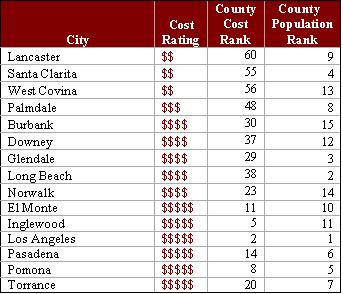By: Larry Kosmont
According to the 2007 Kosmont-Rose Cost of Doing Business Survey, doing business has a high cost in both San Fernando Valley and San Gabriel Valley. All four of the San Fernando Valley cities surveyed had a “High Cost” or “Very High Cost” rating, while 11 of the 20 San Gabriel Valley cities surveyed had at least a High Cost rating.
The Survey, now in its 13th year, and started by renowned real estate consultant, Larry Kosmont of Kosmont Companies, ranks cities as Very Low Cost ($), Low Cost ($$), Medium Cost ($$$), High Cost ($$$$), or Very High Cost ($$$$$) based on various business licensing fees, utility rates, and property taxes. While not all elements in the Survey factor into the cost rating, the Survey also compiles information on cities’ impact fees, business incentive programs, and special economic development zones among other city business incentives and business fees. These incentives and fees add an extra layer of information to bolster or hurt a business’s case for selecting a city.
For example, this year’s Survey rated the City of Glendale as a High Cost ($$$$) city and the City of Pasadena as a Very High Cost ($$$$$) city. Because the Survey is completed on a relative basis, Glendale, without altering its fee structures was shoved into the next category. Unfortunately, this means that Glendale is no longer as competitive as it once was. Pasadena, on the other hand, did increase its business taxes and licensing fees forcing the city into the most undesired category, Very High Cost ($$$$$).
While doing business in the valleys may appear to be expensive, there remain cities in which it is inexpensive to do business. This year, the cities of Temple City, Walnut, West Covina, and La Puente in San Gabriel Valley earned the Low Cost ($$) ranking. Further, three other cities in San Gabriel received a Medium Cost ($$$) ranking: Baldwin Park, Monrovia, and Rosemead.
These cities should be commended for their successes. Just by being in California, these cities are already at a disadvantage: California has notoriously high sales and income taxes that make it difficult for businesses to compete. The higher-cost cities in the valleys reflect a statewide trend; because state support for local governments has diminished over the last two decades, cities often find that their only option is to raise taxes.
California’s high-cost cities are indicative of this underlying problem. The California business community has suffered from statewide taxation, cumbersome worker’s compensation, disability compensation, and minimum wage costs, and a political culture that makes life difficult for cities trying to attract and retain businesses. Moreover, several ballots measures, namely Propositions 13, 62, and 218, have restricted the ability of cities to raise revenue themselves.
Cost Ratings and Rankings for Los Angeles County, CA 15 Most Populated Cities

In order to raise revenues, cities have focused on the “Four R’s”: Redevelopment, Retail, Rooms, and Relocation. Redevelopment creates new sources of property tax; retail creates new sources of sales tax; “rooms,” or hotel taxes, tap into non-local spending; and business relocation brings in disposable income. However, cities too often place too little weight on small business assistance and industrial incentives. Focusing too heavily on the “Four R’s” had made cities dependent on a few unbalanced sources of income that it makes it difficult for them to commit to a long-term economic development plan.
California has become more competitive in recent years, though not by virtue of lessening business costs. Rather, other states have become more expensive through increasing business and property taxes. Several cities surveyed from other states have surpassed San Francisco and Los Angeles since the last Kosmont-Rose Survey. Still, some California cities are also becoming competitive by themselves; some local cities manage to offer competitive fees, tax rates, and economic development programs that can be pivotal for an executive or business owner deciding on a new location.
While the Kosmont-Rose Cost of Doing Business Survey compiles information on several taxes, fees, business incentives, and economic development zones, it should not be the only resource for a company seeking to relocate or expand to another city. There are several factors to consider while moving that the Survey does not address, including quality of life and cost of living, among others. For instance, while California, and San Fernando Valley and San Gabriel Valley specifically, may consistently rank among the more expensive areas, the quality of life and other factors can make them very attractive to businesses.
For more information on the Kosmont-Rose Cost of Doing Business Survey please contact David Huntoon at (909) 621-8159.

|